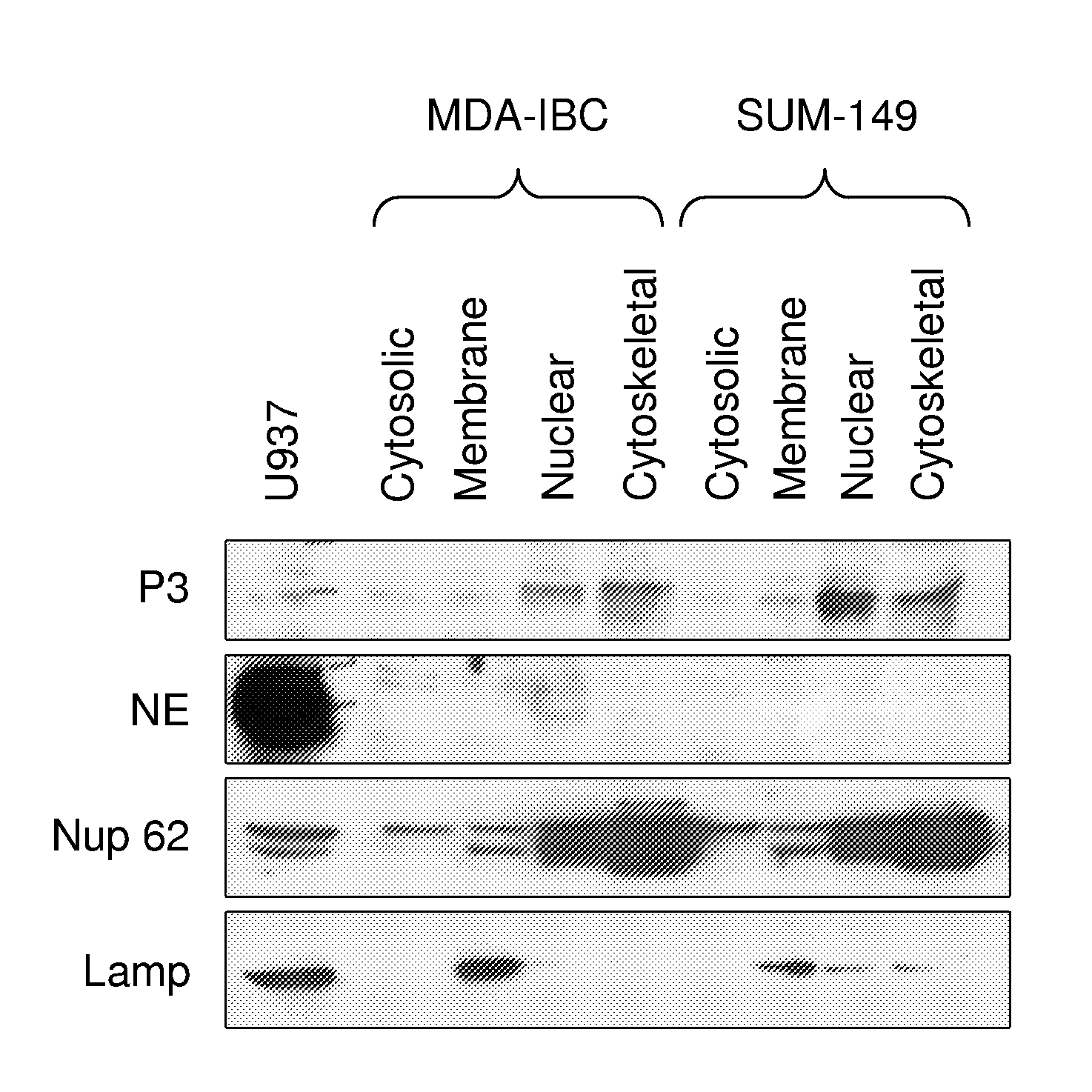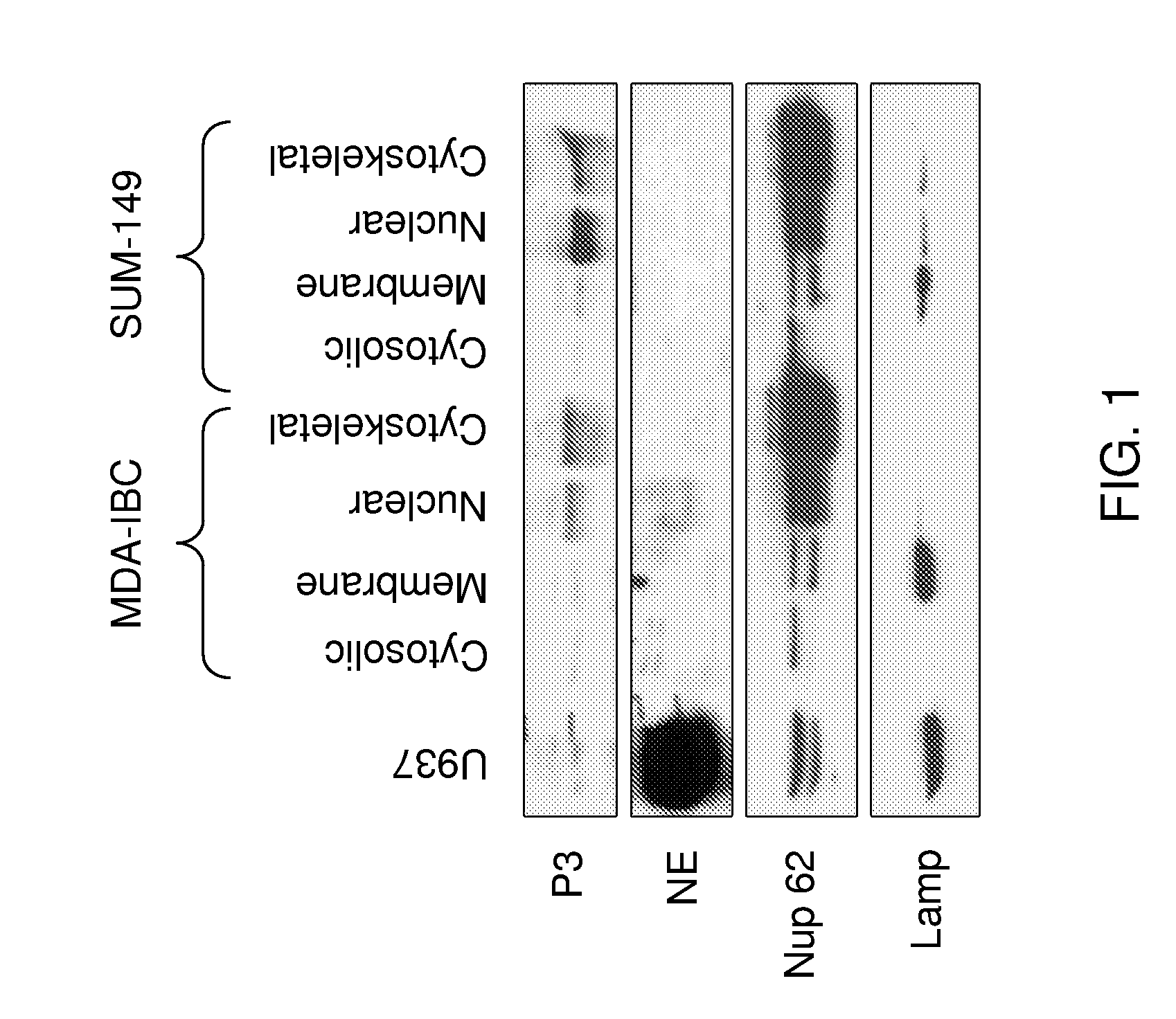Anti-cancer vaccines
a technology of anti-cancer vaccines and vaccines, which is applied in the field of cancer and immunotherapy, can solve the problems of absence of evidence of pr1 efficacy outside of leukemia
- Summary
- Abstract
- Description
- Claims
- Application Information
AI Technical Summary
Benefits of technology
Problems solved by technology
Method used
Image
Examples
example 1
Exemplary PR1 and Breast Cancer Embodiments
[0222]Data has accumulated over the past 30 years showing that the serine proteases proteinase 3 (P3) and neutrophil elastase (NE) are aberrantly expressed in both primary human breast cancer cells and breast cancer cell lines, but not in normal mammary tissue (Finlay et al., 1993; Sato et al., 2006; Yamashita et al., 1994). NE has been shown to cleave cyclin E into its constitutively active high molecular weight isoforms, and NE expression in breast cancer has been shown to have prognostic significance (Harwell et al., 2000; Akizuki et al., 2007; Desmedt et al., 2006; Foekens et al., 2003; Porter et al., 2001). The inventor has previously analyzed tissue-derived mRNA to show that NE and PRTN3 are not expressed in normal human breast tissue.
[0223]PR1, an HLA-A2-restricted peptide, is derived from both P3 and NE, and it is recognized on the surface of myeloid leukemia cells by cytotoxic T lymphocytes (CTL) that preferentially kill leukemia a...
example 2
Exemplary Clinical Trials
[0226]Based upon pre-clinical studies, the toxicity and efficacy of PR1 peptide vaccination for patients with breast cancer is investigated. A study is conducted in two phases: a Phase I initial toxicity phase (in order to determine initial vaccine safety), and a Phase II efficacy and toxicity phase.
[0227]PR1 peptide is injected subcutaneously in incomplete Freund's adjuvant every 3 weeks for 3 injections to induce a PR1 specific host response against breast cancer. Both in Phase I and in Phase II, patients will also be evaluated for signs of immune reactivity. Before, during, and at the end of the 9 week period of vaccination, the peripheral blood mononuclear cells (PBMC) from the patients will be tested for the development of PR1 immune reactivity in vitro using cytotoxic T lymphocyte precursor frequency (CTLPf) assays against PR1-loaded target cells and against the patient's own breast cancer (a measure of efficacy), PR1 / HLA-A2 tetramer staining, 8-color ...
example 3
Illustrative and Exemplary Leukemia Embodiments
[0235]As further provided below, in these Examples, there is disclosure for PR1 embodiments employed for immunity to leukemia. The skilled artisan, based on the teachings in Example 1 and with the following Examples as a guideline, can utilize the following description in characterizing PR1 and other peptides for breast cancer treatment and / or prevention.
Generation of PR1-CTL and Ex Vivo Studies
[0236]Methodology. PR1 peptide was combined into the binding region of the HLA-A2 heavy chain, and the resulting protein folded with β2-microglobulin and attached the resulting PR1 / HLA-A2 monomer onto 50 nm magnetic microbeads (Miltenyi Co.) (Wang et al., 2000). To do this, the technology used was adapted to assemble PR1 / HLA-A2 tetramers, where heavy chain monomers are biotinylated at the C terminus and combined in a 4:1 molar ratio with streptavidin, which has in turn been conjugated to phycoerythrin (PE). The PR1 monomer-conjugated microbeads c...
PUM
| Property | Measurement | Unit |
|---|---|---|
| viscosity | aaaaa | aaaaa |
| viscosity | aaaaa | aaaaa |
| temperatures | aaaaa | aaaaa |
Abstract
Description
Claims
Application Information
 Login to View More
Login to View More - R&D
- Intellectual Property
- Life Sciences
- Materials
- Tech Scout
- Unparalleled Data Quality
- Higher Quality Content
- 60% Fewer Hallucinations
Browse by: Latest US Patents, China's latest patents, Technical Efficacy Thesaurus, Application Domain, Technology Topic, Popular Technical Reports.
© 2025 PatSnap. All rights reserved.Legal|Privacy policy|Modern Slavery Act Transparency Statement|Sitemap|About US| Contact US: help@patsnap.com



